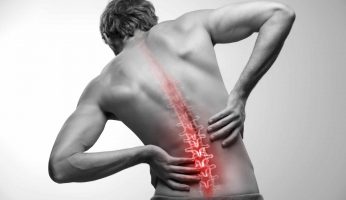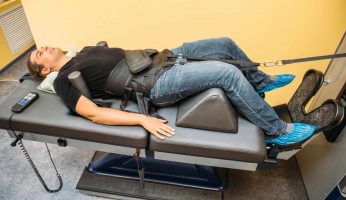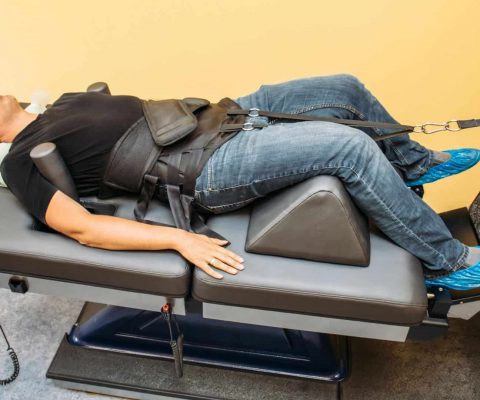A Physical Therapist’s Perspective on Back Pain
Disclosure: We use affiliate links and may receive a small commission on purchases.
 A Physical Therapist’s Perspective on Back Pain
thefitbay.com
A Physical Therapist’s Perspective on Back Pain
thefitbay.com
Back pain is one of the most prevalent musculoskeletal conditions in today’s society. In my practice as a physical therapist, I see people who have issues with neck, back, shoulder, elbow, wrist, hand, hip, knee, ankle and foot problems. I would estimate that at any one time, my caseload in the clinic is about 35-40% patients with back pain.
Occasionally, I see patients that have just had back surgeries such as spinal fusions, laminectomies, disc surgeries, or other surgical procedures; however, most patients that I see are experiencing back pain without a specific cause. These people often have similarities in terms of how they move, how they understand pain, how they respond to their pain, and the mistakes they make that end up worsening their condition.
What Problems Typically Occur in Those with Back Pain?
There is a plethora of problems that may be present in those with back pain. Here, I will review the most common ones that I see within my practice:
- Structural Deficits
Let’s get this one out of the way. There are many people that I see have structural deficiencies in their spine such as bulging discs, osteoarthritis, stenosis, spondylolisthesis, etc. These could be causing their pain, but many times these are not the cause of their problems. More on that in a later section. - Decreased Mobility
Many people that experience back pain have decreased movement in either their spinal joints, spinal musculature, or their hips. This decreased mobility limits movement, puts stress on joints, muscles, and ligaments, and typically worsens as time goes by if not addressed. - Decreased Strength
Several people have a decrease in their core and hip strength which fails to provide their spine with the support it needs during daily movements. - Decreased Neuromuscular Control
Other people might be strong and mobile, but they don’t have the awareness of when and how to activate their muscles when needed in order to perform movement properly. - Poor Movement Patterns
The previous three things in addition to lack of practice and bad habits lead to people performing basic daily movements like squatting, bending, and lifting, with poor technique. Eventually, this may lead to pain and lack of functionality.
What Symptoms Do People with Back Pain Experience?
Common symptoms that my patients with back pain are as follows:
- Pain in the lower back that may be a constant achiness or sharp with movement
- Radiating symptoms into one of both of the lower extremities
- Stiffness or tightness in the lower back, hips and thighs
- Difficulty maintaining prolonged positioning like sitting, standing, or lying down
- Difficulty with basic movements like walking, squatting, bending, lifting, and twisting
- Numbness or tingling in the lower extremities
- Feeling depressed or discouraged about their condition
What Causes These Problems to Occur?
These symptoms may occur as a result of several different causes. These are the most common ones that I hear or infer in my practice:
- Poor Movement Patterns
Often times when I examine a patient with back pain, they pick things up, squat, push or pull objects, and perform other movements with poor technique. They have likely gotten away with it for a long time, but eventually this poor technique catches up to them. - Sedentary Lifestyle
Modern society has made it easier and easier not to move. Couple this with the fact that many people spend most of their day sitting behind a desk at their jobs, this leads to many muscle imbalances, joint stiffness, weight gain, and other problems.
- Trauma
Many people I see in the clinic who suffer from back pain got into a car accident, fell, or experienced some other type of trauma that caused their back pain. - Wear and Tear
As we age, it is normal that we naturally decline in terms of our joint health, muscle function, and overall functionality. However, age alone is not a strong predictor of whether someone will experience back pain. These age related changes can get slowed down, and even reversed with the right plan and some consistency.
How Do I help My Patients with Back Pain?
There are several different methods that I use to help reduce people’s back pain in my clinical practice. Although there are other interventions that I use on occasion, these are by far the most common ones that I incorporate in my practice.
Exercise
This is my bread and butter, my trump card. Exercise is typically the best thing that someone can do to help their back pain. The caveat is that it needs to be specific to the individual.
For example: if someone has weakness in their hips, their back may overcompensate during movements and over time this may lead to pain. Doing hip strengthening and practicing movement patterns would likely help this person. However, if someone with disc issues needs extension based exercises but instead performs flexion based exercises, their symptoms may worsen.
Specific exercise is the king of all interventions I prescribe because in addition to all of the numerous other benefits exercise provides, it allows people to take control of and manage their symptoms without requiring someone or something else to “fix” them.
Manual Therapy
This intervention involves various hands on techniques that I use to help modulate pain, temporarily improve motion and body awareness, and help my patients relax. I use manual therapy to augment my treatment and to help address specific impairments that someone may have that contribute to their symptoms.
Modalities
These are a variety of treatments that I use such as traction/inversion (e.g. using top inversion tables), heat/ice, electrical stimulation, and ultrasound that can help reduce pain and encourage relaxation of the nervous and muscular systems. With this relaxation and reduced pain will likely come improved movement, which then will in turn lead to more carryover of symptom improvement between sessions.
Dry Needling
Dry needling involves the use of thin, acupuncture style needles that go directly into sensitive muscle tissue with the goal to induce relaxation, improved movement, and decreased symptoms. I use this with the appropriate patients and often times they report decreased tightness and achiness in the backs.
Common Mistakes Made by My Patients During Treatment
Although most people that I treat get significantly better, there are some that do not. And while there is the occasional person who did not improve because of some problem we could not address, most people who did not see the results they wanted made one or more of the following mistakes:
- Not Being Ready to Change
Many times, people with back pain ended up with their symptoms as a result of poor lifestyle choices which accumulated over time and eventually caught up to them. However, if you have ever tried to change a habit, you know that it is very difficult. Asking people to change things they have been doing for weeks, months, or years is challenging, and if they aren’t ready to do that, then their rehabilitation potential is limited. - Not Trusting the Process
I tell everyone that walks through the clinic door with back pain that their symptoms will get better if they are patient and trust me to help them. Unfortunately, we live in an instant gratification society. Although I can certainly help people improve and see results in a gradual manner, getting where they want to be rarely happens overnight. This is even more applicable to those people that have been in pain for months or years.I have found that if people trust the process of physical therapy, most will succeed in reaching their goals with patience and consistency. Those who are not patient will likely not succeed. - Not Doing Their Homework
All of my patients get a short set of exercises to perform at home in order to help address their limitations and help them reach their goals. It’s always surprising to me to see how many people do not perform their home exercise program. I understand that life happens, but all it takes is 5-15 minutes a day to perform the exercises I prescribe and they will see improvements.
If you went to the doctor with an infection and were prescribed medication, would you refuse to take the medication and then complain about not getting better?
- Thinking They Are Fragile or Broken
I have heard people say “I have a bad back,” or “I threw my back out bending over” more times than I can count. What’s worse is that I have several patients that have come to me saying something like: “my doctor says I have (insert X-ray or MRI results here) and that’s what’s causing my pain. I can’t do (insert activity that causes pain) anymore.”These things make rehabilitation an uphill battle for many people. Part of this is that the general population has a poor understanding of the body and pain. Some of this is on us as healthcare providers doing educating what pain means and how the body works. I am here to tell you right now: Your body is resilient and you do not have to be afraid of moving even if you have pain!In most cases, pain is a signal that is telling us that something needs to change. Pain is essential to our survival, and acknowledging it and figuring out it’s source is what will keep us moving well our whole lives.For those who think that they did something and now their spine is misaligned or out of place, fear not. Your body can handle some heavy activity. If it couldn’t, we wouldn’t be able to do things like running, jumping, picking things up, playing sports, or anything else without turning into a pile of mush.
- Over-reliance on Someone to “Fix” Them
There are many people who want relief and want to achieve it with as little effort as possible. They turn to treatment methods that promise relief and often deliver it short term, but the reality is that these methods are not effective treating the problem long term. As a result, they often get addicted to the short term relief they receive and constantly seek more of it without getting long term results.If you get stuck in this loop, you need to be honest with yourself. Do you think what your doing is working, or do you need to find something that will be more of a long term solution?In my practice, I want to help people as much as I can to achieve their goals. I can do many things that will help someone feel better, but the most valuable thing I can do is to teach someone how to not need me anymore. When a patient becomes self-reliant to manage their symptoms and looks to me as more of a guide than someone who can “fix” them, I know I have done my job.
So There’s Hope, Right?
Back pain is very frustrating to deal with, but it is also very treatable. The key is identifying what are the root causes of the symptoms and addressing them with an appropriate treatment plan. If you cannot identify these things yourself, find a physical therapist, chiropractor, or other healthcare provider who can help you and guide you along the correct path to help you reach your goals.
Remember that you are not fragile. And remember that your x-ray or MRI does not define you. I have had numerous patients who were diagnoses with severe stenosis or disc herniations and were told they would always have pain. They walked out of my door in 3 months totally pain free. Why can’t that be you?
If you are experiencing back pain that occurred within the past 2 weeks, don’t wait. Address it now so that it does not become a recurring issue. If you have been experiencing back pain for months or even years, be patient. The pain likely did not come up overnight and is likely not going to be fixed overnight. But with the right plan of action and some consistency, you can take control of your symptoms and live the life you want to live!










